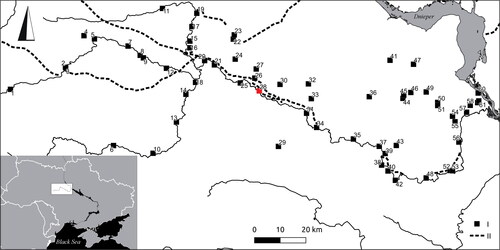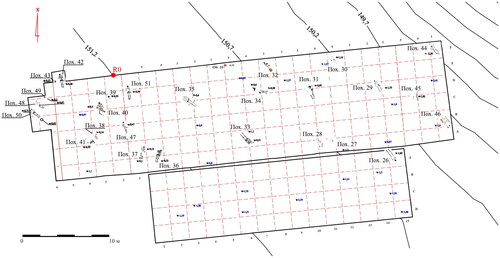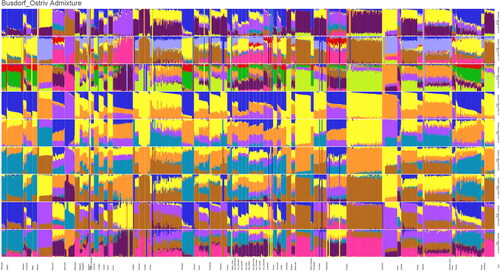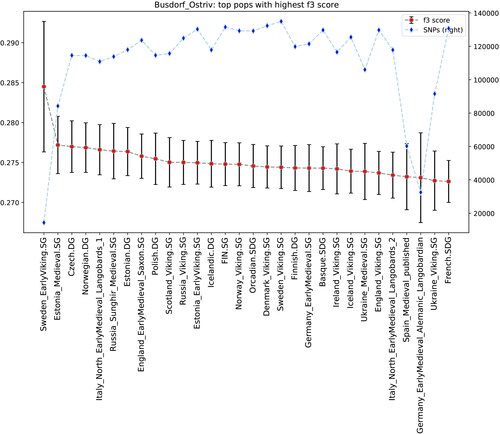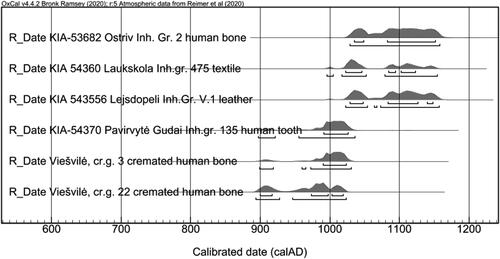 ?Mathematical formulae have been encoded as MathML and are displayed in this HTML version using MathJax in order to improve their display. Uncheck the box to turn MathJax off. This feature requires Javascript. Click on a formula to zoom.
?Mathematical formulae have been encoded as MathML and are displayed in this HTML version using MathJax in order to improve their display. Uncheck the box to turn MathJax off. This feature requires Javascript. Click on a formula to zoom.Abstract
THE LATE VIKING-AGE CEMETERY OF OSTRIV, located approximately 80 km south of Kyiv in the region along the Ros’ River, was discovered by the Institute of Archaeology of the National Academy of Sciences of Ukraine team in 2017. By 2020, 67 inhumation graves had been excavated in an area of 1400 sq m. Most of the artefacts from Ostriv are uncommon in Ukraine, but frequently found in the East Baltic region. This suggests a complex multi-ethnic population, presumably consisting of Baltic region migrants and local Slavs, and represents the easternmost example of its kind. Ostriv is a vivid example of how research on complex, multi-ethnic ancient populations benefits from multidisciplinary international collaborations. This article provides the first synthesis of the archaeological artefacts and burial rites from Ostriv, informed by the results of 14C-dating, stable isotopes, aDNA, physical anthropology and nondestructive metal analyses. It represents an important contribution to the renewed interest in early medieval migration, ethnic complexity and cultural encounters.
Résumé
Des migrants baltes dans la région du Dniepr moyen. Étude comparative du complexe archéologique de la fin de l’ère viking à Ostriv, en Ukraine par Roman Shiroukhov, Vyacheslav Baranov, Vsevolod Ivakin, Oleksandra Kozak, Artem Borysov, Claus von Carnap-Bornheim, Lorenz Kienle, Ben Krause-Kyora, John Meadows, Khurram Saleem, Ulrich Schuermann, Justina Kozakaitė, Žydrūnė Miliauskienė et Gunita Zariņa
Le cimetière d’Ostriv datant de la fin de l’ère viking et situé à environ 80 km au sud de Kiev, dans une zone longeant la rivière Ros, a été découvert par une équipe de l’Institut d’archéologie de l’Académie nationale des sciences d’Ukraine (IA NASU) en 2017. En 2020, 67 sépultures avaient été fouillées sur une superficie de 1400 m2. La plupart des artefacts d’Ostriv, qui ne sont pas courants en Ukraine, sont en revanche fréquemment retrouvés dans l’est de la région balte. Cela suggère une population multi-ethnique complexe, dont on présume qu’elle comprend des migrants de la région balte et des slaves locaux, et qui constitue l’exemple le plus à l’est de ce genre. Ostriv est un exemple frappant des avantages qui découlent de collaborations disciplinaires internationales pour l’étude des populations multi-ethniques anciennes complexes. Cet article fait la première synthèse des artefacts archéologiques et rites funéraires d’Ostriv, sous l’éclairage des résultats de diverses études : datation au 14C, isotopes stables, aADN, anthropologie physique et analyses non destructives des métaux. Il contribue de façon importante au regain d’intérêt pour les migrations, la complexité ethnique et les rencontres des cultures du début du Moyen-Âge.
Zussamenfassung
Baltische Migranten in der mittleren Dnipro-Region. Eine vergleichende Untersuchung des spätwikingerzeitlichen archäologischen Komplexes von Ostriv, Ukraine von Roman Shiroukhov, Vyacheslav Baranov, Vsevolod Ivakin, Oleksandra Kozak, Artem Borysov, Claus von Carnap-Bornheim, Lorenz Kienle, Ben Krause-Kyora, John Meadows, Khurram Saleem, Ulrich Schuermann, Justina Kozakaitė, Žydrūnė Miliauskienė und Gunita Zariņa
Das spätwikingerzeitliche Gräberfeld von Ostriv, das etwa 80 km südlich von Kiew in der Region entlang des Flusses Ros liegt, wurde 2017 vom Team des Instituts für Archäologie der Nationalen Akademie der Wissenschaften der Ukraine (IA NASU) entdeckt. Bis 2020 hatte man auf einer Fläche von 1400 m2 67 Körpergräber ausgegraben. Die meisten Artefakte aus Ostriv sind in der Ukraine selten, treten jedoch in der ostbaltischen Region häufig auf. Dies deutet auf eine komplexe multiethnische Bevölkerung hin, die sich vermutlich aus den Migranten aus dem Baltikum und einheimischen Slawen zusammensetzte, und stellt das östlichste Beispiel dieser Art dar. Ostriv ist ein anschauliches Beispiel dafür, wie die Erforschung komplexer, multiethnischer antiker Populationen von multidisziplinärer internationaler Zusammenarbeit profitiert. Beruhend auf den Ergebnissen von C14-Datierungen, Stabilisotopenanalysen, aDNA-Analysen, physischer Anthropologie und zerstörungsfreien Metallanalysen bietet dieser Artikel die erste Synthese der archäologischen Artefakte und Bestattungsriten aus Ostriv. Er leistet einen wichtigen Beitrag zum erneuten Interesse an frühmittelalterlicher Migration, ethnischer Komplexität und kulturellen Begegnungen.
Riassunto
Migranti baltici nella regione centrale del Dnieper. Uno studio comparato del complesso archeologico di tarda età vichinga di Ostriv in Ucraina di Roman Shiroukhov, Vyacheslav Baranov, Vsevolod Ivakin, Oleksandra Kozak, Artem Borysov, Claus von Carnap-Bornheim, Lorenz Kienle, Ben Krause-Kyora, John Meadows, Khurram Saleem, Ulrich Schuermann, Justina Kozakaitė, Žydrūnė Miliauskienė e Gunita Zariņa
Il cimitero di tarda età vichinga di Ostriv, situato pressappoco a 80 km a sud di Kiev nella regione che costeggia il fiume Ros’, fu scoperto nel 2017 dall’équipe dell’Istituto di archeologia dell’accademia nazionale ucraina delle scienze (IA NASU). Entro il 2020 in un’area di 1400 m2 sono state portate alla luce 67 tombe a inumazione. La maggior parte dei manufatti emersi a Ostriv sono inconsueti in Ucraina, ma si trovano spesso nella regione baltica orientale. Questo indica che si tratta di una complessa popolazione multietnica che consisteva presumibilmente di migranti dalle regioni baltiche e di slavi locali, ed è l’esemplare più orientale del suo genere. Ostriv è un chiaro esempio di quanto la ricerca su antiche popolazioni complesse e multietniche tragga vantaggio dalle collaborazioni internazionali multidisciplinari. Questo articolo fornisce la prima sintesi sui manufatti archeologici e sui riti di inumazione a Ostriv, ottenuta basandosi sui risultati delle analisi delle datazioni 14C, sulle misurazioni degli isotopi stabili, sul DNA antico, sull’antropologia fisica e sulle analisi non distruttive dei metalli. Costituisce un importante contributo al rinnovato interesse per la migrazione altomedievale, per la complessità etnica e per gli incontri culturali.
INTRODUCTION
In October 2017, researchers from the Institute of Archaeology of the National Academy of Sciences of Ukraine (IA NASU) identified a medieval cemetery on the right south bank of the River Ros’, between Ostriv and Pugachivka in the Rokytne district, approximately 80 km south of Kyiv. Sixty-seven human inhumation graves were found in a 1400 sq m excavated area located on a 65 ha terrace above the river’s floodplain. Test excavations at the Old Sukholisy hillfort, 500 m away on the opposite site of the river, dated the site to the 11th–12th centuries ().Footnote1 Artefacts found at Ostriv are markedly different from contemporaneous Kyivan Rus’ artefacts, and can be associated with the historical Western Balts of former East Prussia: Prussians, Curonians, Scalvians and Yotvingians. The Ostriv burials, with the head orientated to the north, are also atypical of Christian Kyivan Rus’ burial rites, but are characteristic of some 10th–11th century cemeteries associated with the Baltic tribes and early Piast Poland.
Fig 1 Location of the Ostriv cemetery in relation to the hillfort and settlement of Sukholisy. Image by A Borisov, V Baranov and V Ivakin.
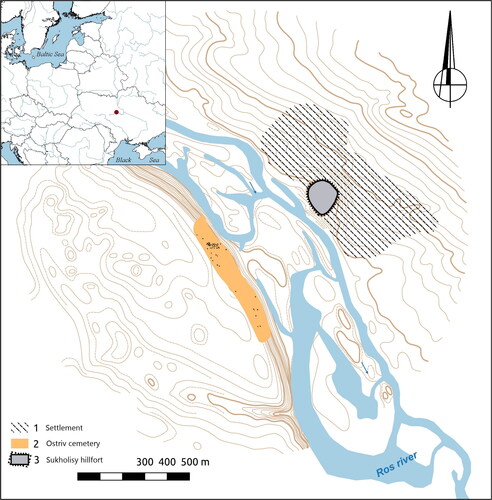
Although the Ostriv cemetery was unknown prior to 2017, the surrounding area had attracted the attention of researchers since 1973, when large-scale field investigations took place along the Ros’. The cemetery area lies in a multiperiod archaeological landscape, with two Chernyakhov/Sântana de Mureș culture (2nd–5th centuries ad) settlements, an amphora of Thasian origin (4th century bc) associated with a destroyed earthen mound, as well as traces associated with Bronze-Age occupation and two early medieval cultures — the Early Slavic Prague (5th–7th centuries ad) and Pen’kivka (5th–7th/8th centuries ad) groups.Footnote2 This chronology complicates archaeological investigation of the early medieval graves, which are found in an almost homogenous layer of black soil, requiring geophysical survey to reveal additional anomalies between the sandy soils of the hillfort/settlement and the black soils of the cemetery. The surface of the cemetery was cultivated for many years, and several burial complexes were partially destroyed by grave robbers — most recently in 2011. The commencement of scientific research and the creation of an IA NASU base in the nearby village of Pugachivka contributed to halting looting activities. Comparative study of the Ostriv cemetery took place in 2018–2020 within the framework of the pilot project, ‘Baltic Migrants in Kyivan Rus’’, which began with the analysis of typological features of Ostriv and East Baltic artefacts, burial rites and 10th–12th-century written sources (). The Ostriv artefacts were compared with supposed Baltic analogues, largely held in the collections of the Lithuanian National Museum (LNM), the Latvian National History Museum (LNVM) and the Museum of Prehistory and Early History in Berlin (SMB/MVF).
Fig 2 The reference data of East Baltic region cemeteries, used in the pilot study to compare the features of Ostriv with Baltic cemeteries Green — the Prussian, Curonian and Scalvian cemeteries analysed during the R Shiroukhov AvH Foundation project in 2017–19; Red — Samogitian, Semigallian, Curonian and Livs cemeteries analysed during the implementation of the Ostriv pilot-project in 2019–20. (1) Alejka-3 (Jaugehnen); (2) Kholmy (Mülsen); (3) Klincovka-1 (Wickiau); (4) Rzhevskoje (Linkuhnen); (5) Viešvilė I; (6) Bikavėnai; (7) Žąsinas; (8) Bandužiai; (9) Ramutten-Jahn (Ramučiai/Girkaliai); (10) Palanga; (11) Pavirvytės Gudai; (12) Raņķu Kapenieki; (13) Doles Vampinieši; (14) Salaspils Laukskola; (15) Lejasdopeli. Image by R Shiroukhov.
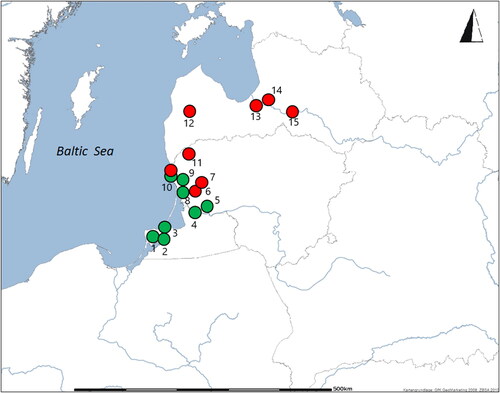
This article provides the first integrated results of the Ostriv excavations and situates them within broader debates on early medieval migration, ethnicity and social identities, using a range of techniques to evaluate the hypothesis that the Ostriv population was a migrant group.
Historical background: Porossya in the 10th–11th centuriesFootnote3
Since the early Viking Age, the road from Scandinavia to Kyiv, also known as the trade route from the Varangians to the Greeks, opened the way for the exchange of goods and ideas.Footnote4 But the border along the Ros’ River — between settled Rus’ and the steppe world — was insecure because of frequent confrontations between the young Kyivan state and local nomadic tribes. The territory of Kyivan Rus’ in the 10th–11th centuries was a point of interaction between the powerful influence of the Byzantine civilization from the south and the accelerating process of urbanisation in the Baltic region to the north. If the west of Kyiv was free for both trade and local warfare, in the south-east, the young Kyivan state faced completely different nomadic cultures. This prompted the princes of Kyiv (of partially Scandinavian origin) to build and fortify the new frontier on the Ros’ River.
The prince of Kyiv, Volodymir Rurikovich, was the first to strengthen the defence of the principality on its southern boundary by erecting the Ros’ defence line’ at the end of the 10th century. Nestor, alleged author of the Primary Chronicle of the first half of the 12th century, described these events which took place in 988:Footnote5
Then Volodymir reflected that it was not good that there were so few towns around Kyiv, so he founded forts on the Desna, the Oster, the Trubezh, the Sula, and the Stugna. He gathered [the] best men of the Slavs, and Krivichs, the Chud, and the Vyatichs, and settled these strongholds with them. For he was at war with the Pechenegs.Footnote6
However, scholars disagree on when the defensive line along the Ros’ was built. Some, referring to the Primary Chronicle, consider the establishment of this fortified frontier to be the work of Volodymir’s heir, Yaroslav the Wise.Footnote7 In 1032, the Chronicle reports that, ‘Yaroslav began to found towns along the Ros’’;Footnote8 he also built the principal town of the region — Yuriev (present-day Bila Tserkva). At the same time, according to Petro Tolochko, separate fortifications on the Ros’ defence line appeared in the late 10th–early 11th centuries during the reign of Volodymir the Great.Footnote9 Yuri Morgunov, drawing on the report of the German missionary, Bruno of Querfurt, dated the appearance of the defensive line along the Ros’ to 1008.Footnote10 In his letter to the Emperor, Henry II, Bruno describes how the enemies raiding the southern borders of Volodymir’s kingdom encountered, ‘the strongest and longest fence’. Bruno travelled to the border accompanied by Volodymir, a journey which took two days and most probably took place in the Porossya region.Footnote11 It is clear, therefore, that contemporary written sources are ambiguous about the exact time when the Ros’ was fortified. The Ros’ valley and its numerous tributaries with its diverse landscape mosaic was not permanently settled around 1000 ad.Footnote12 Until 2017, evidence suggested the area only supported a sparse population residing in small, irregular settlements by the end of the 10th century.Footnote13 By the second half of the 11th century, the southern border of Kyivan Rus’ was protected by several defensive lines of hillforts and sets of ramparts, situated along the rivers. Volodymir’s successor, Yaroslav Rurikovich, purposefully settled these lands. From the mid–11th century, light cavalry corps, referred to as ‘our own pagans’, meaning Turkic-speaking nomads in the service of the dukes of Kyivan Rus’ (Torks and Berendei), were stationed near Torchesk.Footnote14
The settlement of the Ros’ area was achieved through the relocation of people from the interior of the Kyivan state. The Nestor Chronicle reports how various cultural groups (eg Poles and Torks), established extensive settlements at the frontier. The settlers were partly captives of the princes of Kyiv, which is explicitly stated in the Chronicle’s description of the settlement of prisoners from Cherven cities.Footnote15 Porossya formed as an ‘autonomous’ Kyivan region in the middle of the 11th century. The peculiarities of this territory included the multicultural character of its population, its direct subordination to the Kyivan princes and its concentration on the needs of the defensive line to function. Nomads (Pechenegs and, later, Torks and Kipchacks) and other migrants and mercenaries (Masovians/Poles) became part of this defensive system in the second half of the 11th century. The abundance of hillforts and unfortified settlements is evidence of the intensive economic development of the region in the 11th century.Footnote16 In this respect, the hillforts and lengthy ramparts on the frontier protected Kyiv from the nomads in the south (). To date, there has been no investigation of the character of the archaeological features that can be attributed to the various groups who settled in the Ros’ frontier. The evidence from Ostriv cemetery represents the first potential material trace of these migrants.
The funerary rites at Ostriv cemetery
The initial analysis of the funerary rites at Ostriv included 53 burials in different states of preservation, excavated in 2017–18 (). As a result of the shallow depth of the inhumed bodies, the active agricultural use of the area, and systematic looting, a significant number of these burials (15 burials/28.3%) are completely, or partially (14 burials/26.4%), disturbed. Approximately one-third of these burials have traces of wooden constructions (perhaps coffins) in the form of individual boards and nails (), which points to a good level of organic preservation at the site in general. The use of wooden burial structures is widely known in early medieval eastern Europe, including the East Baltic region.Footnote17 Some have regarded the use of nails in funerary contexts as the result of Christian influence.Footnote18
Fig 5 The graves of Ostriv with the remains of wooden constructions (coffins, etc). (1) Grave 19; (2) Grave 12; (3) Grave 16; (4) Grave 46; (5) Grave 40; (6) Grave 42. Image by I Zocenko.
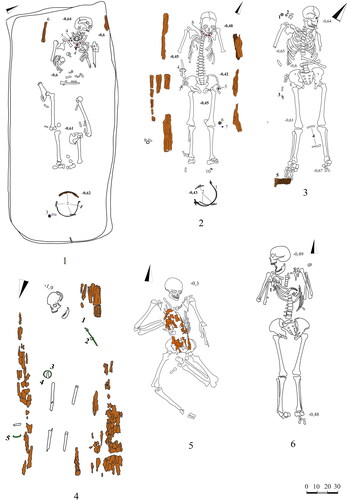
The deceased were laid out supine, mostly with outstretched limbs. No other patterns were detected in the position of the limbs — in one burial (16), the left arm was laid on the stomach, while the other limbs were stretched out; in another burial (19), the right arm lay on the stomach, the left arm on the left shoulder and the legs were stretched out; in another (42), both arms were bent and lay on the chest, while the legs were similarly stretched out. In burial 40, the right arm lay on the chest, the left arm was outstretched, and the legs were tucked in with the right knee bent and the left foot pulled up to the pelvis. This person was probably buried in a ‘sitting’ position. Sitting burials are well known in contemporaneous cemeteries and are usually associated with the northern Russian funerary tradition.Footnote19
The majority of Ostriv burials are oriented with the head to the north or north-west/north-east (28 burials/52.83%). Burials also face west (nine burials/16.98%) and south (four burials/9.75%). The northern orientation is not typical for the Southern Rus’, the Slavic area, or Viking Age Scandinavia.Footnote20 Of the 1100 graves at Haithabu, only around 100 inhumation graves have a N–S orientation (with E–W deviations), of which only three date to the end of the 8th–10th centuries.Footnote21 In contrast, two 9th–10th century cemeteries with N–S-oriented inhumation graves are known in Norway.Footnote22 Lubor Niederle and later researchers have linked the northern orientation of the deceased to the Finno-Ugric funerary tradition.Footnote23 Only a few artefacts characteristic of Finno-Ugric culture (perhaps Livs?) have been found at Ostriv. Traditionally, the western orientation of burials in Scandinavian cemeteries is considered to reflect the influence of Christianity, while the northern and southern orientations are a manifestation of paganism.Footnote24 Alternatively, some have argued that E–W orientations in Scandinavian Viking-Age cemeteries are the legacy of prehistoric funerary customs.Footnote25
The geographically closest analogy to the Ostriv N–S orientation of inhumations is Bodzia cemetery in central Poland — a large, elite cemetery containing more than 58 graves, richly furnished with arms and imported goods, and mostly oriented to the north. The graves of the earliest phase dated to between 980 and 1030, and probably belonged to members of multicultural retinues (druzhiny). Some features are reminiscent of Ostriv, as well as some Masovian and Pomeranian cemeteries, such as buckles found by the feet in male (and potentially female) graves. As at Ostriv, there were no traces of deposited horses at Bodzia.Footnote26 Whilst some Ostriv individuals could be connected to cemeteries like Bodzia, no East Baltic artefacts, which are abundant at Ostriv, were found at Bodzia. The northern orientation of burials is known in the area inhabited by the Western Balts, but is not characteristic of this group. Cremation was the predominant Western Balt burial rite from the 11th century onwards.Footnote27 One exception is the appearance of inhumation burials with a northern orientation in Prussian-Sambian cremation cemeteries of the 11th–12th centuries ().Footnote28 Inhumation burials are more characteristic of the Eastern Balts and archaeological cultures in the Daugava region. Northern head orientations occur in Semigallian cemeteries, but are more typical of female inhumations (more than 60%) than male.Footnote29 In Latgallian cemeteries, 20–30% of burials are orientated with the head to the north-east or north-west,Footnote30 whilst Daugava Liv inhumation graves typically have a north-western orientation.Footnote31 The cult of the horse was characteristic for the majority of the peoples of the south-eastern coast of the Baltic Sea, as is reflected in their funerary rites and attested occasionally in written sources, but this has not yet been observed at Ostriv cemetery. The only horse remains at Ostriv underlie the inhumation graves and date to the Bronze Age.
Fig 6 Inhumation graves with a northern head orientation of Sambian Peninsula Prussians, found in an area of cremation cemeteries. (a) Ekritten (Vetrovo) Grave 12 — armed man with a rare Rus‘type helmet; (b) Alejka-3, Grave 336 — pennanular brooch with connected star-shape, very typical of the Western Balts (and found at Ostriv) in the 11–12th centuries. Image after Širouchovas Citation2011, .3.
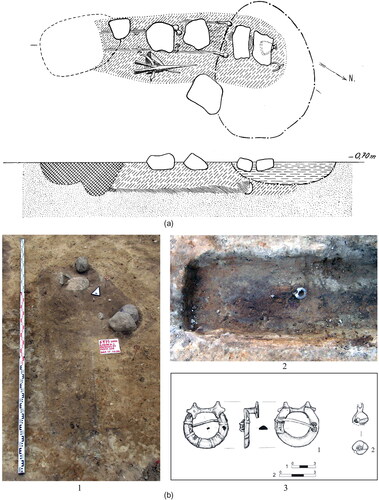
Migrants in Ostriv?
The role of social mobility and migration in the formation of the population at Ostriv is a key question in relation to the ethnic diversity of this militarised frontier of the Kyivan principality. To identify the most probable cultural and geographical origin of the Ostriv paleo-population, the following techniques were used: stylistic and electron microscopic analyses of archaeological artefacts deposited in graves, ancient DNA analysis, dietary stable isotope research and radiocarbon dating (AMS 14C).
Stylistic interpretations of artefacts
Initially, the recovered grave goods from Ostriv were compared to analogues from the Baltic region using conventional morphological features: form, size, decoration, traces of repair, etc (). For example, flat ladder brooches of the A1 Spirģis subtype, characteristic of south-eastern Baltic region cemeteries dating to the end of the 10th–first third of the 11th century,Footnote32 were found in grave 2 and as three stray finds at Ostriv. Three penannular brooches with connected star-shaped terminals and two round brooches with ribbed bows dating to the 11th–12th centuries, especially typical of the Prussians, were found in Ostriv graves 41, 51, 68 and as stray finds.Footnote33 Other penannular brooches with zoomorphic, poppyseed and spiral terminals found in Ostriv graves are also typical of the East Baltic region and Gotland.Footnote34 The same could be said of other ornaments used by the Ostriv people, such as spiral neck rings or zoomorphic bracelets, typical for the Western Balt cultural circle.Footnote35 In contrast to finds from the south-eastern Baltic, none of the Ostriv brooches have traces of repair. Traces of repair or use-wear are common for penannular brooches in Baltic cemeteries and other sites demonstrating the extended life histories of these artefacts. The period of deposition of such artefacts can, therefore, be longer than the period of production. The absence of repaired nonlocal objects at Ostriv, and the absence of any use-wear, may be indirect evidence of recent importation. This is also suggested by the absence of later types of artefacts at Ostriv, as all the types mentioned are mostly dated to the 11th century, with some slightly broader chronologies in a few cases. Besides the connections with the territories of the Balts, it is possible to relate some of the artefacts from Ostriv to sites in the Lower Daugava, and the islands of Saaremaa and Gotland.
Fig 7 Western Balt-type artefacts found at Ostriv: (1) Neck ring, bronze, grave 53. (2) Penannular brooch, bronze, grave 2. (3) Penannular brooch, bronze, grave 23. (4) Penannular brooch, bronze, grave 13. (5) Penannular brooch, bronze, grave 35. (6) Pennanular brooch, bronze with white-metal alloy. (7) Pennanular brooch, bronze with white-metal alloy. (8) Bracelets, bronze, grave 2. (9) Flat ladder brooch, bronze, grave 2. (10) Bracelet, bronze, grave (11) Bracelet, bronze, grave 2. (12) Bracelet, bronze, grave 12. (13) Bracelet, bronze, grave 53. (14) Chain-distributor, bronze, grave 2. Images by A Sorokun and A Suprun.
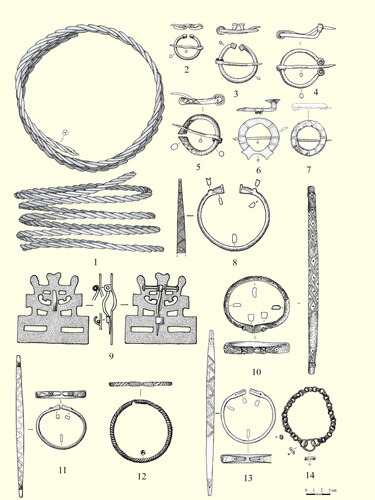
Arms found at Ostriv are typical for Kyivan Rus’ and north-eastern Europe more broadly. Other elements, such as buckets from two Ostriv male graves, are also found at 11th-century Prussian cremation and Pomeranian and Masovian inhumation cemeteries of military elites.Footnote36 The only obviously Kyivan Rus’ artefacts at Ostriv are Ovruch reddish slate spindle-whorls, found in graves 2 (female) and 41 (male), in both cases found together with Western Balt fibula types. Slate spindles are rarely found in Kyivan Rus’ mortuary contexts but are frequently found in 11th-century cremation graves of the Sambian Peninsula’ Prussians and Scalvians, with the majority (up to 95%) in graves containing horse harnesses and/or arms.Footnote37 In this respect, the Ostriv burial rites could reflect the use of typical and widely available Kyivan Rus’ artefacts within a Baltic migrant funerary context. In turn, nonlocal artefacts may be the result of trade or gift-giving.
Electron microscopic analysis of metal artefacts
To investigate whether brooches and other ornaments at Ostriv have the same regional origin, nondestructive analysis of typologically identical metal artefacts from south-eastern Baltic cemeteries and Ostriv was undertaken to compare production technologies. This is the first time this approach has been applied to Baltic and eastern European finds. Ten metal samples from eight 10th–13th century cemeteries in the Kaliningrad region of Russia and western Lithuania, from part of the former Prussia Sammlung housed in Berlin (SMB MVF), along with eight samples from Ostriv cemetery, were analysed at the CAU Institute for Materials Science laboratory, Kiel (, ). The observed differences in their morphology and crystal structure of the selected metal artefacts suggested there were differences in their manufacturing process. This analysis also revealed major differences in chemical composition, such as the use of bronze or copper, and variations in the content of minor elements such as lead.
Fig 8 Distribution showing the origin of the archaeologically derived metal samples: former East Prussia (Kaliningrad region of Russia and western Lithuania). (1) Ekritten (Sirenevo); (2) Grebieten (Povarovka/Pokrovskoje); (3) Linkuhnen (Rzhevskoje); (4) Löberstoff (Slavjanskoje); (5) Popelken (Prudovka); (6) Ramutten-Jahn (Girkaliai); (7) Trentitten (Zajcevo); (8) Viehof (Tiulenino). Image by R Shiroukhov.
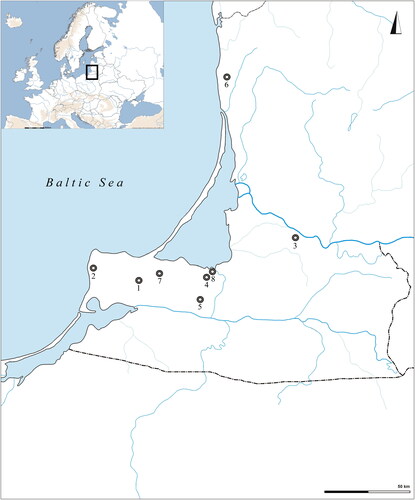
Table 1 Metal samples from former East Prussia, kept at the SMB-MVF Berlin, used for electron microscopic analysis: ID 2383–2387, 2989 and 2891 — Kaliningrad region of Russia, ID 2388, 2890 and 2892 — West Lithuania. By K Saleem and R Shiroukhov.
Transmission electron microscopy (TEM) and scanning electron microscopy (SEM) were used to perform morphological analysis with high spatial resolution, combined with energy dispersive X-ray spectroscopy (EDX) and elemental composition data.Footnote38 Electron transparent samples needed for TEM were prepared using the focused ion beam technique (FIB). This was used to extract a thin slice (a lamella of a thickness between 50 nm and 100 nm) from a depth of 10 μm from the surface of the Ostriv flat ladder brooch found in grave 2 (). The extracted slice is < 1/6th mm, invisible to the naked eye. EDX point measurements and elemental maps were performed in scanning TEM mode to directly measure elemental composition and distribution over the sample.
Fig 9 Thin slices (lamella of a thickness between 50 nm and 100 nm) taken from a depth of ten micrometres from the surface of various artefacts: (1) Ramutten-Jahn flat ladder brooch; (2) Ostriv flat ladder brooch; (3) Ramutten-Jahn flat laddar brooch within the Focused Ion Beam microscope region; (4) Location of FIB lamella extraction. Image by L Kienle, K Saleem and U Schuermann.
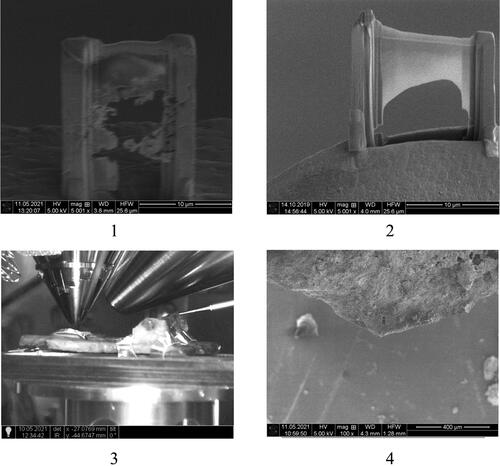
The analytical results from two flat ladder brooches from Ostriv and Ramutten Jahn (Lithuania, former East Prussia) are displayed in . The elemental map of the flat ladder brooch from Ostriv shows a homogenous distribution of zinc (Zn) and copper (Cu) with some oxidation (). Surprisingly, Zn was not detected in the Ramutten Jahn flat ladder brooch. These preliminary results show a difference in the production mechanism of these artefacts, and demonstrate the importance of the FIB for nondestructive sample preparation and the possibilities of electron microscopy for comparative fabric analysis.
Fig 10 The elemental map of the flat ladder brooch from Ostriv grave 2, which demonstrates a homogenous distribution of zinc (Zn) and copper (Cu) with some oxidation. Image by L Kienle, K Saleem and U Schuermann.
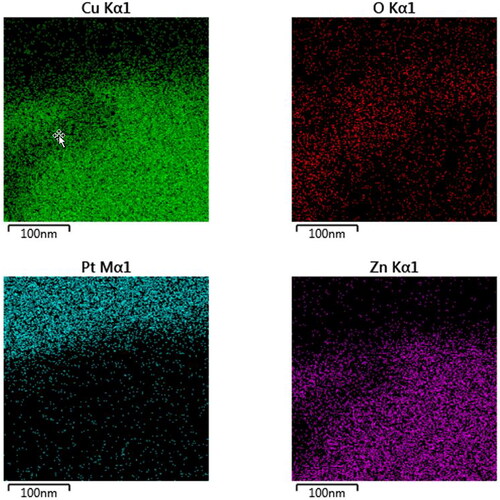
Table 2 Comparison of the point measurements averages taken from different regions on the lamella with the composition of the flat ladder brooches from Ostriv and Ramutten-Jahn (Lithuania, former East Prussia). By L Kienle, K Saleem and U Schuermann.
Physical anthropology and paleopathology
During 2017–19, the skeletal remains of 66 individuals from Ostriv cemetery were studied at the IA NASU. The sex and age of the skeletons were determined using standard methods.Footnote39 For estimating the stature of adult individuals,Footnote40 humerus and femur lengths were measured using Martin’s technique.Footnote41 Pathological conditions observed on bones were recorded following the protocols used by the Palaeopathological Group of the Medical University of Göttingen, Germany.Footnote42 The diagnosis for some diseases was informed by Mays.Footnote43
Most graves contained a single individual, but in several cases there was evidence for probable group internments, where individuals were laid closely and parallel to each other. These included female and child (graves 42 and 43), or male, female and child (graves 48, 49, 50). Skeletal preservation ranged from poor (with one or two bones preserved) to very good (complete). Seventeen (25.8%) burials were of subadults younger than 14 years, most under six years old. Seven graves belonged to juveniles. Twenty-four individuals (36.4%) were determined as adult males and 18 (27.2%) were identified as females. The largest number of adults died between the ages of 20 and 30 (35.2% of the total group; ). It is assumed that this is the most active age for men and the most dangerous age for women, due to early multiple births and infections. Only three individuals were classified as older than 50 years, two of whom were females. The average age of death for the adult group was 34 years in males and 32.6 years in females. These indicators were lower than those of other contemporary urban populations, but higher than in some rural populations of the Middle Dnipro region.Footnote44 Postcranial skeletal morphology of the individuals is characterised by relative gracility and is of medium diversity. Average male stature was estimated at 169.7 cm (ranging from 159.3 to 177.2 cm); the stature of females averaged 162.8 cm (ranging from 157.7 to 167.1 cm). Both male and female ranges appeared to be within the limits estimated for medieval Rus’ and adjacent regions.Footnote45 The high frequency of some genetic variations recorded in the Ostriv population, among them suture bones (61.1%), fontanelle bones (15.2%) and metopic sutures (13.2%), could be explained by close familial links within the group (). In contrast, in medieval Rus’ towns, such as Kyiv or Lubech, metopic sutures persisting into adulthood were only found in 0–12.6% of individuals.Footnote46
Fig 11 Range of stature (minimum-average-maximum) of the males (n = 14) and females (n = 10) in Ostriv cemetery.Footnote95 Image by O Kozak.
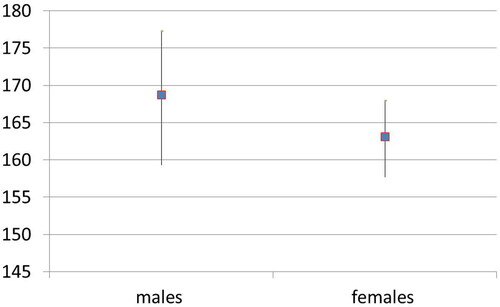
Table 3 Age and sex distribution in the Ostriv ancient (%, n=66). By O Kozak.
Seven out of 18 (38.9%) females had one to three antemortem injuries per person, mainly situated in the hands and in the chest. Two females had healed foot fractures. There were also antemortem healed depression fractures on the frontal bones of two females. Out of the 28 males, 17 (60.7%) had suffered between one and five traumas per individual. Most of them had healed injuries of the chest: compression fractures of the vertebral body, splitting of the vertebral joints and possible traumatic spondylolysis and spondylolisthesis, as well as rib fractures in three cases. Fractures were also located on the clavicle shaft of two males. Seven persons had injuries in the ankle region. Most of the observed trauma within the group can be interpreted as occasional or occupational, with the exception of a double-penetrating perimortem wound on the cranial vault of a 30- to 35-year-old male from grave 18.
Dental health indicators point to poor hygiene along with a mixed diet rich in carbohydrates and proteins. Dental cavities occurred in 58% of adults, more often in females than in males, and were also seen on the deciduous teeth of four subadults. Nearly every person in the group had calculus at a different stage of development. Complications of tooth disease, such as periodontal diseases and antemortem tooth loss, were as common in females as in males. Lineal transversal enamel hypoplasia was recorded in 76.5% of males and 88.2% of females. The frequency of this lesion is very high for the region, as in Kyiv this ranges from 29% to 70% and in rural Rus’ populations it is not higher than 46% ().Footnote47
Table 4 Pathological traces observed on skeletal remains from the Ostriv ancient population. By O Kozak.
Pathological lesions on children’s bones in Ostriv cemetery correspond primarily to scurvy. Other diseases diagnosed in subadults were meningitis, otitis media, mastoiditis and possible pleura inflammation. These conditions could lead to early death of children or provoke the stress episodes that cause enamel hypoplasia in surviving adults. In the adult group, the most common were traces of inflammation of the paranasal sinuses and middle ear (). Another lesion that usually manifests itself on the long bones is the unspecific periosteal reaction on the femur, tibia, or fibula shaft in a half of the Ostriv population (). This multifactoral symptom can be caused by post-traumatic inflammation or systemic bacterial infection.Footnote48 In most cases, it is difficult to specify the diagnosis without histological or microbiological tests, so is considered to be a nonspecific stress marker in the group. Unhealed lesions were seen in the population mostly in individuals younger than 30, whereas in older females and males the bone reactions were healed and integrated. Such a differentiation could possibly reflect stress in young adult individuals, whose deaths were connected with various infections.
Signs of a meningeal reaction, both inflammatory and haemorrhagic, were found in a third of adults, mostly in young females, and in twice as many subadults ().Footnote49 Some cases were unspecific. Specific features such as antemortem confluent groups of pits were detected at the base of the skulls along with a meningeal reaction on the internal surface of the cranial bones.Footnote50 In some cases, the irregular porosity of the ventral surface of the vertebral body, diffuse periostitis on the visceral surface of the ribs,Footnote51 and fine porous striation on the diaphysis of the long bones were considered additional signs of the disease.Footnote52 If the pits at the cranial base and meningeal reaction were found along with other lesions, a diagnosis of tuberculosis was suggested. This condition occurred in 27% of adults and 25% of subadults (). There was no evidence for advanced joint or spinal disease in the group. The frequency of the lesions is relatively high for the Middle Dnipro region, as in the large town of Kyiv it occurred in 15% of individuals.Footnote53
Another lesion which is not common in the area is external auditory exostoses (EAE). These are considered to be the consequences of chronic exposure to damp wind, cold water and other conditions of coastal areas.Footnote54 In the group from Ostriv, traces of chronic inflammations with exostoses in the outer auditory canal were found in 51.5% (of 33) adults — in eight out of 15 males and nine out of 18 females (). In general, the frequency of both specific and unspecific subacute changes on the bones, such as unhealed periosteal and meningeal reaction, could be regarded as indicators of the maladaptation of the paleo-population,Footnote55 and are possibly connected to the early death of some Ostriv inhabitants. These also might be the consequences of the change in the populations’ environment,Footnote56 and could support the migration hypothesis for the origin of the group.Footnote57
Fig 12 Exostoses in the external auditory meatus (EAE): (a) The skull of the female from grave 12, aged 25–30 years. Exostosis on the posterior wall of the right external channel; (b) Left temporal bone of the female from grave 25, aged 25–35 years. Exostosis on the posterior and anterior walls of the narrowed external auditory channel. Photographs by O Kozak.
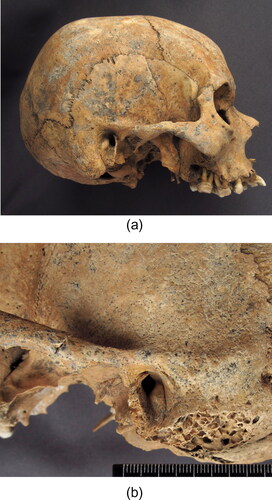
Ancient DNA analysis
aDNA analysis at the Institute of Clinical Molecular Biology CAU, was used to compare the ancient population of Ostriv to other contemporary populations of the East Baltic region that are represented by cemeteries with similar artefacts and burial features. Seven samples of petrous bone from six graves (nos 2, 6, 41, 47, 51 and 53) were analysed. These were compared to 12 individuals from the Viking-Age cemetery of Haithabu/Busdorf (Germany).
DNA was extracted and converted into partial Uracil-DNA Glycosylase (hUDG) libraries, following laboratory guidelines for aDNA work.Footnote58 Shotgun sequencing was performed on the Illumina HiSeq 6000 (2 × 100) platform of the Institute of Clinical Molecular Biology (IKMB) in Kiel. The shot-gun data were quality controlled by using ClipAndMerge v1.7.7.Footnote59 and mapped to the human genome (build hg19) using BWA v0.7.15.Footnote60 Duplicates were removed with DeDup v0.12.1.Footnote61 The authenticity of sequences as ancient was assessed by calculating terminal damage of reads with DamageProfiler (fast damage pattern calculation for ancient DNA) v1.1.Footnote62 Possible DNA contamination was estimated by analyzing sequence with Schmutzi v1.5.5.5,Footnote63 and ANGSD v0.935.Footnote64 Samples that showed more than 5% mtDNA or X chromosome contamination were excluded from further analysis.
The genotyped samples in this study were merged within a reference panel containing previously published genotypes of 10,438 ancient and modern individuals.Footnote65 For population genetic analysis, in order to classify an individual reliably, at least 20,000 pseudo-haploid genotypes of 1,233,013 SNP pre-defined genetic positions in the human genome were used ().Footnote66 The PCA Principal Components Analysis (PCA) was performed with smartpca.Footnote67 Shared genetic drift was calculated with the program qp3Pop from the admixtools package in the format f3 (sample population; test population, Mbuti).Footnote68 An unsupervised ADMIXTURE v1.3.0 analysis was performed on the resulting dataset,Footnote69 using a range of 4 to 12 components (K) with 10 bootstraps each. Cross-validation error was calculated for each model to identify the best K component. Two- and three-way admixture models were tested with qpadm from admixtools.Footnote70
Table 5 Genetic samples from Haithabu/Busdorf and Ostriv used in the study. By B Krause-Kyora.
Preliminary analysis of all seven Ostriv samples yielded successful genetic sex determinations (three women and four men). In one case, this determination contradicted the individual’s estimated sex based on physical anthropology and gravegoods. DNA from three Ostriv individuals (KH190349, grave 6; KH190352, grave 47; KH190354, grave 53) were well enough preserved to perform genome-wide population analyses. The Ostriv samples were analysed together with three individuals (KH190098, KH190101 and KH190103) from Haithabu/Busdorf (Germany) and compared to previous Scandinavian aDNA analyses.Footnote71 The Ostriv individuals cluster with present-day Icelandic and Baltic populations. They are on the edge of the variability of previously published Swedish Vikings and close to Ukraine Vikings and later dated medieval individuals from Estonia (). The individuals from Busdorf, conversely, show higher diversity and fall more centrally within the variability of the different Viking groups that have been published. Other medieval groups from central Europe, such as the Saxons, are clearly separated from the Viking-Age individuals from Scandinavia and Ukraine. Using the f3 statistics of direct genetic relationship of populations, the samples show the greatest correlation with individuals from modern-day Lithuania and Estonia, followed by Iceland (). Therefore, the aDNA signatures demonstrate the Ostriv individuals are closer to the Balts, Fino-Ugrians and Scandinavians.
Stable isotope analysis
Dietary stable isotopes (δ13C, δ15N and δ34S) were measured in eight Ostriv human bone samples taken for 14C dating, partly in order to determine whether these individuals consumed significant amounts of marine or freshwater protein (). Fish are normally depleted in 14C, compared to terrestrial species, giving rise to dietary 14C reservoir effects (DREs) in fish consumers, whereby their 14C ages are misleadingly old.Footnote72 Collagen extracted for 14C dating at the Leibniz Laboratory, Christian Albrechts University, Kiel (see below), was analysed by EA-IRMS (elemental analysis-isotope ratio mass spectrometry) at isolab GmbH, Schweitenkirchen, Germany. The results are averaged measurements of up to four aliquots of each sample; measurement uncertainties are probably better than ±0.1‰ for δ13C and δ15N, and ±0.3‰ for δ34S. The results also allow us to compare the diets of individuals buried at Ostriv to the diets of individuals buried in contemporary East Baltic cemeteries (, ). Dietary interpretation of human stable isotope values is well established.Footnote73
Fig 16 Human bone collagen δ13C values from Ostriv, plotted against δ15N (left) and δ34S (right) values in the same extracts. For comparison, values in individuals from several contemporaneous cemeteries in the East Baltic (mainly tooth samples) are also shown. Image by J Meadows.
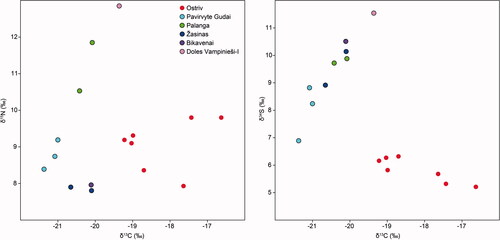
Table 6 Ostriv samples stable isotopes indicators. By C Hamann and J Meadows.
Table 7 East Baltic cemeteries stable isotopes indicators. By Ch Hamann and J Meadows.
Fish consumption may affect the values of all three stable isotope ratios in human collagen, depending on differences in these ratios between terrestrial and aquatic foods, for which we have no local reference data for the medieval period (some prehistoric δ13C and δ15N reference data for the Dnipro valley have been published).Footnote74 Both δ13C and δ34S values are expected to vary geographically and may overlap between terrestrial and aquatic species,Footnote75 but trophic-level enrichment in 15N means that elevated human δ15N values (often >12‰) are usually associated with the longer food-chains in aquatic ecosystems, regardless of geography. All the Ostriv human δ15N values are relatively low, however (<10‰), and there is no correlation between higher δ15N values and higher 14C ages (, left), suggesting that differences in 14C age between individuals are not due to differences in fish consumption (). Conversely, the Ostriv δ13C values are apparently correlated with δ34S and perhaps also with 14C ages (, right), which may imply differential consumption of low-trophic-level aquatic species (which could affect 14C ages without a clear effect on δ15N). We regard this explanation as unconvincing.
Fig 17 Human δ15N (left) and δ13C (right) values plotted against 14C ages of the same collagen extracts. Error bars correspond to 1-sigma measurement uncertainties. Image by J Meadows.
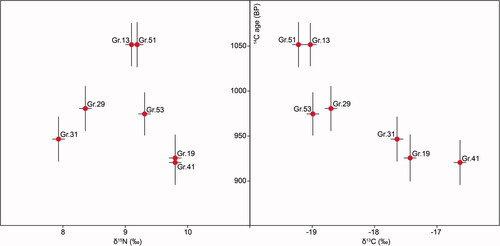
Instead, the spread of δ13C and δ34S values at Ostriv could reflect a mixture of local and East Baltic residence, with values closer to those found in East Baltic cemeteries occurring in more recent immigrants. The fact that these cases (Ostriv graves 29 and 53, and particularly 13 and 51) have higher 14C ages would then imply that only the earlier burials were of individuals raised in the East Baltic, whereas later burials were of individuals who had spent their lives mainly or entirely in the territory of today’s Ukraine. Given the elevated δ13C values in the later burials, it is presumed that a C4 plant (presumably millet) was consumed more regularly in Ukraine than in the East Baltic. This interpretation is discussed further below. Although δ15N enrichment due to nursing,Footnote76 may have influenced the isotope values of the teeth sampled from the East Baltic cemeteries (particularly the Doles Vampenieši case, a young child), the wide range of δ13C, δ15N and δ34S values () may also reflect differential consumption of marine fish, which typically have higher values than terrestrial animals and plants. This would imply that East Baltic 14C ages may be subject to modest dietary reservoir effects. Even if some of the Ostriv individuals retain a residual isotopic signal of residence in the Baltic region, however, this signal appears to be at the terrestrial end of the spectrum of isotopic values associated with Baltic cemeteries. A discussion on the dietary landscape of the Kyivan state around this time period could also help contextualise future isotopic studies.
Radiocarbon dating
Radiocarbon (14C) dating was used to establish the absolute chronology of the Ostriv burials and to synchronise them with graves with similar/identical artefacts up to 1000 km away in Lithuania, Latvia, Poland and the Kaliningrad region of Russia. The Ostriv 14C results also provided a site chronology that can be compared to documented historical events in Ukraine. Eight human bones and a wood sample from Ostriv were dated by Accelerator Mass Spectrometry (AMS) at the Leibniz Laboratory for Radiometric Dating and Stable Isotope Research of CAU, Kiel, following standard protocols for collagen extraction (bones) and acid–base–acid pre-treatment (wood; ).Footnote77 Collagen preservation was excellent (yielding mostly over 10%) in all bone samples. Extracts were combusted, graphitised and measured by AMS, following established procedures for 14C age calculation.Footnote78 The results are expressed as conventional 14C ages,Footnote79 with 14C/12C concentrations corrected for natural fractionation using the simultaneously measured AMS 13C/12C ratios ().
Fig 18 Ostriv 14C-dating results. Top: 14C ages calibrated to calendar dates using IntCal20 and the program OxCal v.4, without any allowance for intrinsic age.Footnote96 Bottom: calibrated 14C ages are shifted later by a normal (N, eg 5 ± 5 calendar years) or uniform (U, eg 10–100 calendar years) distribution to account for intrinsic age at burial. These dates (outline distributions) are likelihoods for corresponding burial dates in a Bayesian chronological model, which assumes that they represent a single unordered phase of activity, with start and end dates determined by the scatter of burial dates (grey distributions). The model, created in OxCal v.4, produces posterior density estimates (black distributions) for the dates of individual burials. Coloured bars represent the reigns of Vladimir the Great (ad 980–1015) and Yaroslav the Wise (ad 1019–1054). All dated burials could have occurred during Yaroslav’s reign. Image by J Meadows.
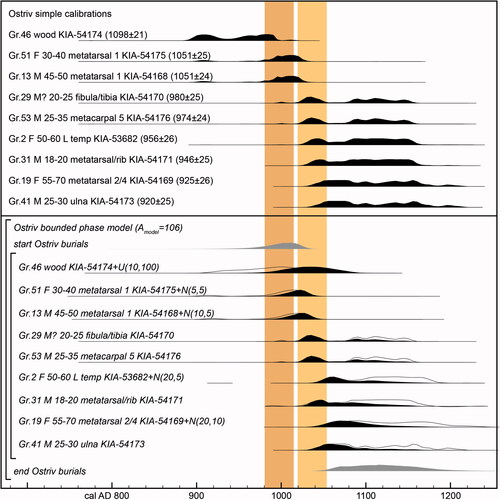
Table 8 Ostriv cemetery 14C-dated samples. By J Meadows and R Shiroukhov.
Simple calibration of the 14C ages suggests that two individuals (graves 13 and 51) date to the end of the 10th century, or more probably the start of the 11th century; the pine-wood sample from grave 46, with an unknown intrinsic age, probably dates to the 10th century.Footnote80 All other burials appear to date to a plateau in the calibration curve between c 1040 and 1160 ad. Allowing for a modest wood-age offset in grave 46, one reading of the results would be that they represent a brief period of burial in the early–mid-11th century (). This interpretation can be formally modelled, using the Bayesian chronological modelling software OxCal v.4.4,Footnote81 as a simple bounded phase of activity. If the duration of burial activity is not artificially constrained, the model output also includes early 12th-century solutions permitted by the calibration plateau between c 1040 and 1160, but the 14C results are all compatible with all burials having occurred in the early–mid-11th century ( lower). Our model incorporates small calendar-age offsets to better account for the intrinsic age of the wood dates in grave 46, and for collagen turnover time for the bone samples from mature adults. All these samples were from bones that are continuously remodelled throughout life, but the rate of remodelling will have varied according to factors including the skeletal element sampled and the age-at-death of the individual concerned. Slow remodelling can produce collagen 14C ages corresponding to dates decades before death,Footnote82 and stable isotope values reflecting average diet over a similar period of time.Footnote83
DISCUSSION
Bringing all of this data together, it is now possible to address the main research question set out at the start of this article: are the individuals in Ostriv cemetery migrants, local, or both?
14C and Stable Isotope Evidence
Two readings of the Ostriv 14C results appear to be permitted by the data. Our preferred model, in which dietary reservoir effects are assumed to be negligible, locates the burials in the early–mid-11th century cal ad, and interprets patterns in the 14C, δ13C and δ34S values as the effect of dietary changes over individual lifetimes, probably due to migration from the East Baltic to Ukraine. Individual δ13C and δ34S values would correspond to what proportion of collagen in the sampled bone was formed in the East Baltic, and what proportion was formed after the individual moved to Ukraine, and began consuming terrestrial foods with higher δ13C values, such as millet, and lower δ34S values. While there are few if any local reference δ34S data for either region, a predictive model supports our inference that terrestrial δ34S values were 4–6‰ in central Ukraine and 6–8‰ in the East Baltic.Footnote84
An alternative reading is that the apparent correlation between higher 14C ages, lower δ13C and higher δ34S values in the Ostriv burials (, right) primarily reflects differences in consumption of local freshwater fish, which may account for most or all of the differences in 14C ages. It is more difficult to construct a formal chronological model for this interpretation without isotopic data for local fish and terrestrial food sources, and direct measurements of 14C depletion in local fish. Allowing for moderate reservoir effects (up to c 100 14C years) in bones with more negative δ13C and higher δ34S values, all the dated burials might belong to the third quarter of the 11th century, when terrestrial samples have 14C ages of c 920 BP, the lowest 14C age obtained at Ostriv. This would imply a larger wood-age offset in grave 46 (≫100 years) than in our preferred model. However, the absence of a correlation between 14C ages and δ15N values (which are normally quite sensitive to fish intake; , left) favours the interpretation that dietary reservoir effects are negligible and can be disregarded.
The patterns in the 14C, δ13C and δ34S values can probably be better explained by changes over time in individual diets. In this case, samples from graves 13 and 51, which isotopically are closest to East Baltic burials of this period, may represent individuals who began life in the East Baltic and had not lived long enough in what is now Ukraine for their bones to completely remodel, leaving an isotopic record of their Baltic origins in their collagen. Under our preferred model (, lower), graves 51, 13, and perhaps also 29 and 53, correspond to the first wave of migrants, perhaps starting towards the end of the reign of Volodymir the Great (ad 980–1015), but clearly continuing under Yaroslav the Wise (ad 1019–1054). Those Ostriv individuals with ‘local’ stable isotope signatures (graves 2, 19, 31 and 41) died either towards the end of Yaroslav’s reign, or in subsequent decades. These individuals were either born locally, or had lived in Ukraine for a significant period of time.
Comparative analysis of Ostriv and East Baltic cemeteries
On the basis of similarities in funerary rites, types of archaeological artefacts, and the availability of samples, two East Baltic cemeteries were chosen for comparison with the physical anthropological data from Ostriv: Laukskola (Latvia) and Pavirvytė Gudai (Lithuania). The 10th–13th-century cemetery of Laukskola contains 610 burials of Livs, Wends, Semigallians and Scandinavians: 425 inhumations, 165 cremations and 20 symbolic burials. Age and sex were determined for 128 inhumations and 111 cremations. Out of all the sex-identified graves, 71 belong to children (0–14 years), 105 to adult males and 63 to adult females. Among the inhumations, the number of adult males and females is almost equal — 32 and 27 individuals, respectively, which is similar to Ostriv. Of Laukskola’s males, 37.5% died aged 15–30, but 48% of the adult males died aged 40–54. Thus, the situation is a little different to Ostriv, where the majority of adult males died before the age of 40. Female mortality at Laukskola, where 33–40% were aged 15–24 and 28–37% died aged 30–39, is closer to Ostriv.Footnote85 In general, it can be noted that the population of Laukskola, who were presumably sedentary, appear to have had a longer lifespan than the population of the frontier cemetery of Ostriv. Graves 79, 474 and 475 at Laukskola were 14C dated to compare them chronologically to those graves at Ostriv with similar artefacts ().
Fig 19 Latvian inhumation cemeteries samples, used in the study, 14C-dating results. Image by R Shiroukhov.
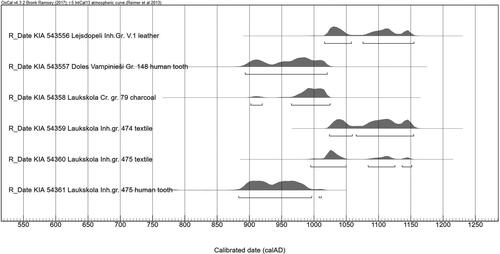
The skeletal remains from Pavirvytė Gudai Semigallian/Curonian cemetery were analysed anthropologically for the first time. Previously, Pavirvytė’s gender-data were determined largely based on the burial rites and gravegoods. However, we cannot draw clear demographic conclusions from the gravegoods in Pavirvytė alone, in contrast to Ostriv and Laukskola cemeteries. At Pavirvytė Gudai, out of 165 10th–12/13th-century graves, 115 are inhumations and 28 are cremations. Only 143 funeral features were identified out of 165. Based entirely on grave goods, out of 94 graves, 59 (63%) belong to males, 25 (27%) to females and nine (10%) to children. This situation is more typical for other East Baltic cemeteries, where female graves are represented by 18–20% of the cemeteries’ populations,Footnote86 than for the more ‘egalitarian’ Ostriv cemetery with its even male to female ratio and higher rate of child mortality. New analysis of Pavirvytė Gudai burials No 74, 135, 138 and 141, including anthropology, radiocarbon dating, stable isotopes and genetics, was carried out as a part of the Ostriv pilot study (). Unfortunately, the condition of the skeletal remains had significantly deteriorated since the excavation. Only one skull (grave 74), one mandible (138) and two sets of teeth (135 and 141) were available for further analysis. The material was fragmented and affected by weathering, and as a result sexing was impossible. The age was estimated by assessment of dental development.Footnote87 The skull from grave 74 belonged to a 6- to 10-year-old subadult. The individual from grave 138, according to the development of the permanent dentition, died at approximately 20 to 30 years of age. Only teeth were present for two individuals from graves 135 and 141. According to the degree of dental attrition and wear, the individual from grave 135 would have been no older than 18–20 years at the time of death. The individual from grave 141 would have been 17–25 years at the time of death. The anthropological data from those inhumation graves with artefacts and burial rites at Pavirvytė Gudai, similar to those at Ostriv, suggest a link between the two sites.
Long-distance connections between Ostriv and East Baltic cemeteries
The regional connections represented in Ostriv can be explored further by comparing the chronologies of specific artefact types at Ostriv and East Baltic sites. Initially, the difference in the metal composition of the flat ladder brooches, identified during the electron microscopic analysis, can be attributed to different provenances. The fibula from Ostriv was most likely not made in the same workshop as that from Ramutten. Again, considering the potential for recycling and mixing of raw materials, the lack of Zn might just mean that the Ostriv object was cast in a different episode than the one from Ramutten.
In order to synchronise the typo-chronology of distant sites, grave 2 at Ostriv was compared with four inhumations and one cremation grave in Latvia and Lithuania (). All of the graves contain flat ladder brooches of Spirģis A1 subtype (). All the burials have been 14C -dated and (apart from the cremation) analysed anthropologically and using stable isotopes. Ostriv grave 2 has a N-W head orientation and is of a woman who died aged 50–60 years from multiple diseases. While the presence of two slate spindles brings grave 2 closer to the Kyivan Rus’ cemeteries (and unexpectedly to Sambian Peninsula equestrian cremation graves), the other artefacts (bracelets, brooches) are of Baltic origin. These grave goods may be dated typologically between the late 10th and the mid-11th century.Footnote88 Grave 475 at Laukskola, a multicultural cemetery in the area of Daugava Livs, is a child inhumation with a N-W head orientation. Numerous gravegoods include arms and ornaments, among which is the Spirģis A1 brooch. Typo-chronologically, grave 475 can be dated to the 11th century.Footnote89 The Lejasdopeli cemetery is located lower on the Daugava river and is attributed to the Selonians. Barrow mound V, grave 1 in the cemetery contained an adult male inhumation, oriented with head to the east and richly furnished with more than 30 grave goods, including several 11th-century Anglo-Saxon, German and Danish coins. The numismatic evidence includes Otto and Adelheid denars providing a terminus post quem between 990 and 1040/1050 ad. The end of the 10th- to the first half of the 11th centuries correlates well with both the typo-chronological and 14C dates of Ostriv grave 2 and grave 475 at Laukskola.Footnote90 The Pavirvytė cemetery has many features in common with Ostriv, such as Western Balt ornaments and a N-W head orientation. Grave 135 at Pavirvytė contained, along with two flat ladder brooches of the Spirģis A1 and Bliujienė IV types, other artefacts that date typologically to the 11–12th centuries. The young woman (18–20 years) in Pavirvytė grave 135 was oriented with her head to the north-west, like the woman in Ostriv grave 2. Sixty-three percent of Pavirvytė female graves have the north (north-west, north-east) head orientation ().Footnote91 This chronology is also supplemented by 14C-data of Scalvians Viešvilė-I cemetery (see below).
Fig 21 Distribution of the cemeteries with flat ladder brooches of Spirģis A1 subtype, analysed in the study. (1) Ostriv; (2) Laukskola; (3) Lejasdopeli; (4) Pavirvytė; (5) Viešvilė I. Image by R Shiroukhov, map by A Borisov.
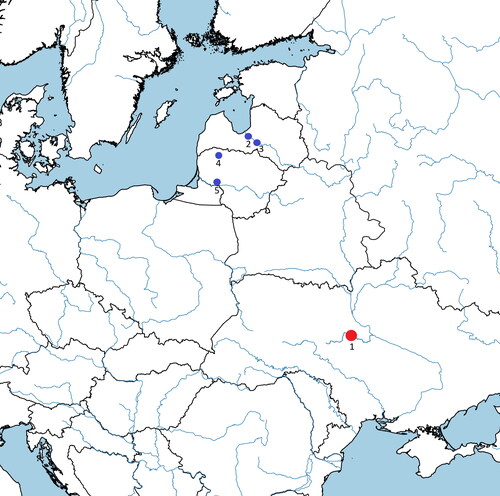
Fig 22 Flat ladder brooches of Spirģis A1 subtype. (1) Ostriv, grave 2. (2) Lejasdopeli, barrow mound V, grave 1. (3) Laukskola, grave 475. (4) Viešvilė I, cremation, grave 22. Image by R Shiroukhov.
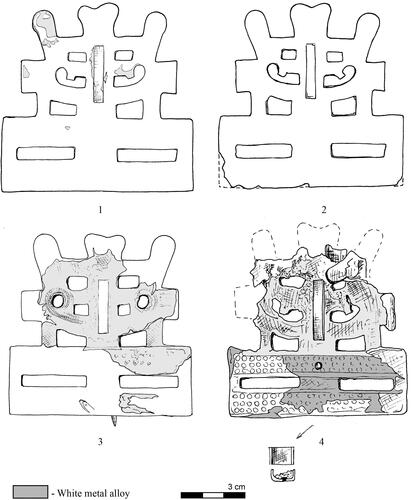
Fig 23 Pavirvytė female graves with a northern head orientation. (A) Ostriv inhumation grave 2, plan and photo of the skeletal remains and gravegoods. (B) Plan of Lejasdopeli burial mound V inhumation grave 1. (C) Pavirvytė Gudai cemetery inhumation grave 135. Image and photograph A by I Zotsenko; Image B from Griciuvienė Citation2007, 59–60, and C from Vaškevičiūtė and Cholodinskienė 2008, fig 32.
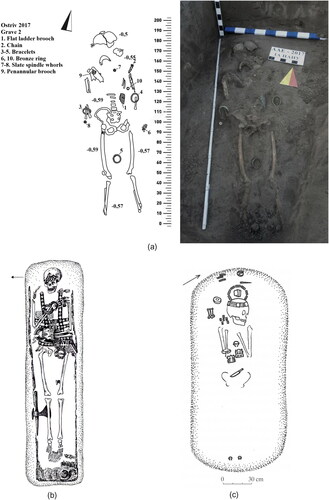
According to our preferred chronological model, Ostriv grave 2 dates to cal ad 1038–1155 (95% probability). The textile sample from grave 475 at Laukskola is dated to cal ad 996–1154 (95.4% probability). Both radiocarbon dates of textile samples from Laukskola graves 474 and 475 are similar to Ostriv grave 2, representing the period from the first quarter of the 11th- to the first half of the 12th centuries (). The radiocarbon date of Lejasdopeli grave 1 is cal ad 1023–1157 (95.4% probability, ). This means that the typological date of the 11th century correlates well with a radiocarbon one, with the last one starting around ad 1020, and is informed by the numismatic dating (ad 990–1040), ie the period when most of the Ostriv graves were supposedly created. The AMS 14C date of grave 135 at Pavirvytė obtained from the girl buried here is 897–1036 (95.4%) or 991–1026 (68.3%) with a radiocarbon curve peak at 980–1030 ad (). Spirģis A1 brooches were found in two cremation graves Viešvilė-I cemetery: 3 and 22. Two samples from grave 3 (cremated human bone and textile) provide a joint estimate for the date of this burial of 899–1025 ad (95.4% probability) or 987–1022 (68.3%). The calibrated date of the cremated bone from grave 22 is 894–1024 (95.4%) or 946–1024 ad (69.8%; , ).Footnote92 According to the radiocarbon and typological dating, production of Spirģis A1 brooches started in the second part/end of the 10th century in the Scalvian and southern Curonian areas. This is indicated by the variety and steady development of previous types of ladder brooches and their presence in the region. Thus, it seems logical to find the earliest graves with such fibulae at Viešvilė, which dates to around 960–1020 ad, after which they appear at Pavirvytė cemetery, dating to around 980–1030 ad.Footnote93 Then Spirģis A1 brooches appear after 1015/1020 ad at Daugava Liv and Selonian cemeteries. Finally, around 1030 ad these brooches came to Ostriv. How did they get there? The reason they would appear later at Ostriv is that the cemetery itself began after the start of A1 brooch production, not that it took decades for these objects to be transported 1000 km.
Fig 24 OxCal combination of 14C dates from textile samples from graves 474 and 475, Laukskola cemetery. Image by R Shiroukhov.

Table 9 14C-dated East Baltic cemeteries samples used in the study. By R Shiroukhov and J Meadows.
It is possible to suggest that the older woman buried in Ostriv grave 2 may have arrived here as an adult already in possession of the fibula, though there is no direct evidence for this. The current dating model is not precise enough to be confident about the possible date this woman arrived. With a 58% probability her date of death could be between ad 1035 and 1085, with a <1% probability of death before 1035. In this respect she would not have turned 20 before c ad 1000, and there is c 40% chance that she turned 20 after ad 1050 (). Returning to the typo-chronology it is important to remember, that in most cases, Spirģis A1 brooches cannot be dated beyond the 11th century. The fact that Ostriv grave 2 is not as early as (or appears to be later than) the dated cases in the East Baltic might be because this individual had a longer life. There could be other undated examples at Ostriv whose owners died earlier. Preliminary connections between Ostriv cemetery and the cemeteries of Latvia and Lithuania are evident. The radiocarbon and stable isotope research of several East Baltic inhumation graves with a northern orientation and the artefacts identical to those from Ostriv confirms this. Thus, the radiocarbon dates from burial mound V, grave 1 in the Selonian Lejasdopeli cemetery, grave 475 in the Daugava Liv cemetery at Laukskola and grave 135 in the Pavirvyte Gudai cemetery of the Curonized Semigallians are similar or identical to Ostriv grave 2. Identical fibulae and AMS 14C dates from different regions of the Baltics bring us closer to clarifying the origins of those buried at Ostriv.
Fig 26 OxCal modelling of the Ostriv Grave 2 14C date, using the anthropological age of the deceased. Image by J Meadows.
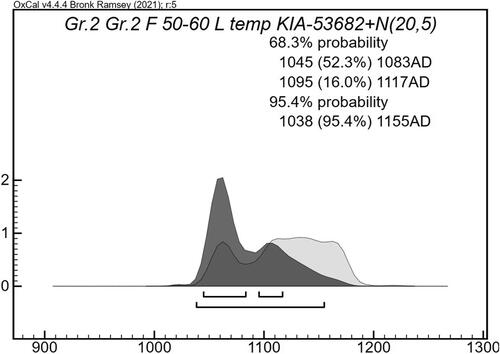
Other connections to the south-eastern Baltic region’s ancient populations, such as the Prussians, are also possible. In the Baltic region, Kyivan Rus’ and other Rus’ imported goods appear in funerary contexts in three general regions: the Lower Daugava (Latvia), the Sambian Peninsula (Kaliningrad region of Russia), and Gotland (Sweden). This is not to diminish the importance of cultural cross-influence of coastal areas of Lithuania and Latvia, north-eastern Poland and Saaremaa. The Sambian Peninsula with its early medieval Prussian cremation cemeteries deserves special attention. This region is where several penannular brooch types found at Ostriv originate as well as some ritual traditions (slate spindles in the graves); the area has an intense concentration of Old Rus' imported goods; and from the 11th century, inhumation graves with northern orientation appear in the Sambian Prussian cremation cemeteries (some of them with Rus’ imports). However, so far none of the Ostriv female burials with Baltic-type ornaments has been found in a ‘native’ (Curonian, Semigallian or Livonian) complete adornment. Some of the typical Baltic ‘male’ fibulae found in some female graves at Ostriv may have been gifts or trade goods. Thus, the pattern of East Baltic cremation and inhumation cemeteries of Western and Eastern Balts and their neighbours, comparable to general Ostriv cemetery features, is rich and rather complicated. A detailed comparative study of these sites is required to further our understanding of the origins of the population at Ostriv.
CONCLUSIONS
The results of the pilot project presented in this article are encouraging, suggesting that the Ostriv population were East Baltic immigrants, who served as mercenaries on the Ros’ River frontier starting from the time of Volodymir the Great, and especially during the reign of Yaroslav the Wise, in the first third to middle of the 11th century ad. Several historical events could be connected to the Ostriv cemetery: the first of several military campaigns of Yaroslav the Wise against the Yotvingians (1038), Lithuanians (1040) and Masovians (1041, 1047).Footnote94 Indeed, our chronological model does not exclude the possibility that all the dated individuals died in the 1030s and 1040s. Typological features indicate the East Baltic origin of most of the ornaments found at the cemetery. This is also indirectly evidenced by various aspects of the burial rites at Ostriv. The similarity of the 14C results, together with stable isotope signatures and the typo-chronological background of Ostriv and East Baltic individuals, may indicate the common origin of the two populations. The first results of the genetic analyses link the Ostriv individuals to Baltic and Scandinavian populations. This corresponds with the preliminary results of the morphological study of Ostriv skeletal remains, which indicate that the Ostriv paleo-population was rather young, with an average age of death of 35 years, and was poorly adapted to the new climate and diseases. It is possible to conclude that we are dealing with a young, relocated population — most likely the first generation of migrants.
This study has also raised new questions. Who were these people exactly? Were they refugees, mercenaries, retainers or another group entirely? Where exactly did they come from? Did males and females arrive together? If they were mercenaries, did they bring their families, or marry locally? Are the men with Kyivan Rus’ weapons and the women with Baltic brooches of different ethnic and cultural origins? How many generations had they been present in this region? Were they still in touch with their lands of origin? The people of Ostriv cemetery most likely belonged to a multicultural ‘fusion’ population, consisting mainly of individuals of East Baltic origin. The discovery of Ostriv also prompts a reconsideration of the predominantly Scandinavian origin of the Varangians or Rus’, who participated in the creation and development of the Kyivan Rus’ state. People from the East Baltic region, as the individuals from Ostriv cemetery demonstrate, also played a role. The integration of eastern Europe into central and northern European networks around the year 1000 ad was a dynamic process, visibly reflected through archaeological sources. Ostriv cemetery, along with other Viking Age sites such as Shestovysia and Chernaya Mogila (Black Grave) in Ukraine, provide a new foundation for comparing and integrating the events and cultural processes of central-eastern Europe during the Viking Age with the Baltic region.
Acknowledgements
The authors would like to thank colleagues from the archaeological departments of the Lithuanian National Museum (LNM) and the Latvian National History Museum (LNVM), and the Museum of Prehistory and Early History in Berlin (SMB/MVF) for the opportunity to work with artefacts and organic samples from East Baltic cemeteries for this research. We are grateful to Aleks Pluskowski and Katherine French for proofreading this text. We would also like to thank Dr. Gunita Zariņa from Latvia University for information about Latvian cemeteries used in the study.
Notes
1 Івакін et al Citation2017, 5–7; Baranov and Ivakin Citation2018, 99–127.
2 Iвакiн et al 2020, 90.
3 ‘Porossya — is the name for the region along the river Ros‘ that is used in the chronicles of the 11th–13th centuries.
4 Shepard Citation2016.
5 The Tale of Bygone Years.
6 Повесть временных лет, 83, 282.
7 Кучера and Іванченко Citation1987, 69–70.
8 Повесть временных лет Citation1950, 101, 301.
9 Толочко Citation1975, 44–6.
10 Моргунов Citation2005, 254–5.
11 Свердлов Citation2017, 44.
12 Моця Citation1993, 18.
13 Мезенцева Citation1968; Петраускас et al Citation2011.
14 Кучера and Іванченко Citation1987, 68.
15 Довженок and Кучера Citation1956, 52–3, Звіздецький and Серов, Citation1988, 70; Кучера and Іванченко Citation1987, 70–71; Wołoszyn Citation2020.
16 Borysov Citation2019, 79–80.
17 Gräslund Citation1980, 15–26, 43; Моця Citation1993, 25, 36–7; Пронин et al Citation2006, 335; Bliujienė Citation2016, 279–80; Širouchovas Citation2011, 285–90; Buko Citation2014, 408–510.
18 Gräslund Citation1980, 43.
19 Ibid 37–39; Жарнов Citation1991, 208; Моця Citation1993, 23, 137; Лесман Citation2014, 80; Михайлов Citation2016, 75.
20 Моця Citation1993, 120; Нидерле Citation2015, 306; Buko Citation2014, 482–92; Gräslund Citation1980, 26; Arents and Eisenschmidt Citation2010, 203–6; Buko Citation2014, 492–503.
21 Arents and Eisenschmidt Citation2010, 203–6.
22 Stylegar Citation2007, 87–8.
23 Нидерле Citation2015, 308; Моця Citation1987, 115–16.
24 Gräslund Citation1980, 26; Buko Citation2014, 492–503.
25 Arents and Eisenschmidt Citation2010, 203–6, 289.
26 Buko Citation2014, 481–3, 507–9.
27 Жулкус Citation2004, 154; Bliujienė Citation2018, 110; Скворцов Citation2010, 191–2; Shiroukhov Citation2012, 235–45; Bliujienė Citation2018, 115, 120–1.
28 Кулаков Citation1990, 21; Пронин et al Citation2006, 72–88; Širouchovas Citation2011, 285–6.
29 Vaškevičiūtė Citation2004, 110; Griciuvienė Citation2007, 52–80; Vaškevičiūtė and Cholodinskienė Citation2008, 23–66.
30 Radiņš Citation1999, 25–7.
31 Zariņa Citation2006, 318, 385–400.
32 Spirģis Citation2002, 67–71.
33 Широухов Citation2017, 134–6.
34 Thunmark-Nylén Citation2000, 173–180.
35 Осипенко and Грицик Citation2020; Diachenko Citation2021.
36 Buko Citation2014; Baranov and Ivakin Citation2018.
37 Shiroukhov Citation2012, 232–4.
38 Deeb et al Citation2004. TEM studies were performed in a FEI Tecnai F30 G² STwin equipped with an EDX detector (Si/Li, EDAX).
39 Brothwell Citation1981; Buikstra and Ubelaker Citation1994; Scheuer and Black Citation2000; Schour and Massler Citation1941.
40 After Pearson Citation1899.
41 Martin 1928; Bräuer 1988.
42 Schultz Citation1988, Citation2001.
43 Mays Citation2020.
44 Козак Citation2000; Citation2010.
45 Козак Citation2010; Drozd-Lipińska and Kozlowski 2016.
46 Бужилова Citation1995; Козак Citation2010.
47 Козак Citation2000; Citation2010.
48 Schultz Citation2001.
49 Ibid.
50 Schultz Citation1999; Spekker et al Citation2020.
51 Lovász et al Citation2010.
52 Schmidt-Schultz and Schultz Citation2015; Citation2015, 82–5.
53 Козак Citation2010.
54 Villotte et al Citation2014.
55 Goodman et al Citation1988, 178.
56 Roberts and Buikstra Citation2003 for TBC and Schultz Citation2020 for periosteal reactions.
57 Козак 2019.
58 Rohland et al Citation2015; Cooper and Poinar Citation2000.
59 Peltzer et al Citation2016.
60 Li and Durbin Citation2009.
61 Peltzer et al Citation2016.
62 Neukamm et al Citation2021.
63 Renaud et al Citation2015.
64 Korneliussen et al Citation2014.
65 Allen Ancient DNA Resource: <https://reich.hms.harvard.edu/> [accessed on 19.09.2022].
66 Haak et al Citation2015; Lazaridis et al Citation2014; Mathieson et al Citation2015.
67 Patterson et al Citation2006.
68 Ibid 2012.
69 Alexander et al Citation2009.
70 Patterson et al Citation2012.
71 Margaryan et al Citation2020.
72 Eg Lillie et al Citation2016.
73 Eg Makarewicz and Sealy Citation2015.
74 Lillie et al Citation2016.
75 Goude and Fontugne Citation2016; Bataille et al Citation2021.
76 Jenkins et al Citation2001.
77 Grootes et al Citation2004.
78 Nadeau et al Citation1998.
79 Stuiver and Polach Citation1977.
80 Reimer et al Citation2020.
81 Bronk Ramsey Citation2009.
82 Calcagnile et al Citation2013.
83 Fahy et al 2017.
84 Bataille et al Citation2021, fig 2.
85 Zariņa Citation2006; Citation2010, 56–71.
86 Vaškevičiūtė and Cholodinsklienė 2008, 18, tab 3; Širouchov Citation2012, 113.
87 Buikstra and Ubelaker Citation1994.
88 Baranov and Ivakin Citation2018, fig 16.
89 Zariņa Citation2006, 128, fig 208, 57–9.
90 Griciuvienė Citation2007, 57–9.
91 Griciuvienė Citation2005, 59–65, Vaškevičiūtė, Cholodinskienė, 2008, 69–70.
92 Shiroukhov Citation2019, tab 1, fig 2.
93 Ibid, 47–48
94 Шахматов 1908, 141; Осипенко and Грицик 2020, 340.
95 According to Pearson Citation1899.
96 Reimer et al Citation2020; Bronk Ramsey Citation2009.
BIBLIOGRAPHY
- Alexander, D H, Novembre, J and Lange, K 2009, ‘Fast model-based estimation of ancestry in unrelated individuals’, Genome Res 19:9, 1655–64. Available online at: https://doi.org/10.1101/gr.094052.109 [accessed on 19.09.2022].
- Arents, U and Eisenschmidt, S 2010, Die Gräber Von Haithabu, Bd. 1. Ausgrabungen in Haithabu, Kiel: Verlag Wachholtz.
- Baranov, V and Ivakin, V 2018, ‘Burials with weaponry in the Ostriv Baltic graveyard in the Middle Dnieper area (excavated in 2017–2018). Medieval warriors in the Slavic and Baltic area’, Acta Historica Universitatis Klaipedensis 37, 99–127.
- Bataille, C P, Jaouen, K, Milano, S et al 2021, ‘Triple sulfur-oxygen-strontium isotopes probabilistic geographic assignment of archaeological remains using a novel sulfur isoscape of Western Europe’, PLoS One 16:5, e0250383, available online at: <e0250383. doi:10.1371/journal.pone.0250383>[accessed on 19.09.2022].
- Bliujienė, A 2016, ‘The Curonians of the Lithuanian Coast’, in G Zabiela, Z Baubonis and E Marcinkevičiūtė (eds), A Hundred Years of Archaeological Discoveries in Lithuania, 268–85, Vilnius: Society of the Lithuanian Archaeology.
- Bliujienė, A 2018, ‘Power of fire: Various customs of burning the dead’, in A Bliujienė (ed), The Klaipeda (Memel) Region: From Origins to the 17th Century, 102–13, Klaipeda: History Museum of Lithuania Minor.
- Borysov, A V 2019, Old Rusj Porossya. Settlement System — Qualifying Scientific Work on the Rights Of Manuscripts (Unpubl PhD thesis, Institute of Archaeology of National Academy of Sciences of Ukraine).
- Bronk Ramsey, C 2009, ‘Bayesian analysis of radiocarbon dates’, Radiocarbon 51:1, 337–60.
- Brothwell, D R 1981, Digging Up Bones, 3rd edn. Ithaca, New York: Cornell University Press.
- Buikstra, J E and Ubelaker, D 1994, ‘Standards for Data Collection from Human Skeletal Remains’, Arkansas Archaeol Survey Res Ser 44.
- Buko, A (ed) 2014, Bodzia. A Late Viking-Age Elite Cemetery in Central Poland, East Central and Eastern Europe in the Middle Ages 450–1450, Leiden, Boston: Brill.
- Calcagnile, L, Quarta, G, Cattaneo, C et al 2013, ‘Determining 14C content in different human tissues: Implications for application of 14C bomb-spike dating in forensic medicine’, Radiocarbon 55:3, 1845–9.
- Cooper, A and Poinar, H N 2000, ‘Ancient DNA: Do it right or not at all’, Science 289:5482, 1139, available online at: <https://doi.org/10.1126/science.289.5482.1139b> [accessed on 19.09.2022].
- Deeb, C, Walter, P, Castaing, J et al 2004, ‘Transmission Electron Microscopy (TEM) investigations of ancient Egyptian cosmetic powders’, Appl Phys A, 79:2, 393–6.
- Diachenko, D 2021, ‘Baltska zoomorfna bronzova plastyka v pokhovalnii obriadovosti mohylnyka Ostriv’, in D V Bibikov (ed), Materialy Naukovoi Konferentsii «Vid Yazychnytstva do Khrystyianstva: Relihiini Viruvannia Rannoserednovichnoho Naselennia Serednoho Podniprov’ia», Vyshgorod-Kyiv: Mistectvo.
- Goodman, A R, Thomas, R B, Swedlund, A C et al 1988, ‘Biocultural perspectives on stress in prehistoric, historical, and contemporary population research’, Am J Phys Anthropol 31:S9, 169–202.
- Goude, G and Fontugne, M 2016, ‘Carbon and nitrogen isotopic variability in bone collagen during the Neolithic period: Influence of environmental factors and diet’, J Archaeol Sci 70, 117–31, available online at: <doi:10.1016/j.jas.2016.04.019> [accessed on 19.09.2022].
- Gräslund, A-S 1980, The Burial Customs. A Study of the Graves on Björkö, Birka 4, Stockholm: Almqvist and Wiksell.
- Griciuvienė, E 2005, Žiemgaliai. The Semigallians: Baltų Archeologijos Paroda. Katalogas, Vilnius: Lnm, Lnvm.
- Griciuvienė, E 2007, Sėliai. The Selonians: Baltų Archeologijos Paroda. Katalogas, Vilnius: Lnm, Lnvm.
- Grootes, P M, Nadeau, M-J and Rieck, A 2004, ‘14C-AMS at the Leibniz-Labor: Radiometric dating and isotope research’, Nucl Instrum Methods Phys Res Sect B: Beam Interact Mater Atoms 223–224, 55–61.
- Haak, W, Lazaridis, I, Patterson, N et al 2015, ‘Massive migration from the steppe was a source for Indo-European languages in Europe’, Nature 522:7555, 207–11, available online at: <https://doi.org/10.1038/nature14317> [accessed on 19.09.2022].
- Jenkins, S G, Partridge, S T, Stephenson, T R et al 2001, ‘Nitrogen and carbon isotope fractionation between mothers, neonates, and nursing offspring’, Oecologi 129:3, 336–41.
- Korneliussen, T S, Albrechtsen, A and Nielsen, R 2014, ‘ANGSD: Analysis of next generation sequencing data’, BMC Bioinformatics 15, 356, available online at: <https://doi.org/10.1186/s12859-014-0356-4> [accessed on 19.09.2022].
- Lazaridis, I, Patterson, N, Mittnik, A 2014, ‘Ancient human genomes suggest three ancestral populations for present-day Europeans’, Nature 513:7518, 409–13.<https://doi.org/10.1038/nature13673> [accessed on 19.09.2022].
- Li, H and Durbin, R 2009, ‘Fast and accurate short read alignment with Burrows-Wheeler transform’, Bioinformatics 25:14, 1754–60. <https://doi.org/10.1093/bioinformatics/btp324> [accessed on 19.09.2022].
- Lillie, M, Henderson, R, Budd, C et al 2016, ‘Factors influencing the radiocarbon dating of human skeletal remains from the Dnieper river system: Archaeological and stable isotope evidence of diet from the Epipaleolithic to Eneolithic periods’, Radiocarbon 58:4, 741–53, available online at: <doi:10.1017/RDC.2016.33> [accessed on 19.09.2022].
- Lovász, G, Pálfi, G, Marcsik, A et al 2010, ‘Skeletal manifestation of tuberculosis in a late medieval anthropological series from Serbia’, Acta Biol Szeged 54:2, 83–91.
- Makarewicz, C A and Sealy, J 2015, ‘Dietary reconstruction, mobility, and the analysis of ancient skeletal tissues: Expanding the prospects of stable isotope research in archaeology’, J Archaeol Sci 56, 146–58, available online at: <doi:10.1016/j.jas.2015.02.035> [accessed on 19.09.2022].
- Margaryan, A, Lawson, D J, Sikora, M 2020, ‘Population genomics of the Viking world’, Nature 585:7825, 390–6.
- Mathieson, I, Lazaridis, I, Rohland, N et al 2015, ‘Genome-wide patterns of selection in 230 ancient Eurasians’, Nature 528:7583, 499–503. Available online at: <https://doi.org/10.1038/nature16152> [accessed on 19.09.2022].
- Mays, S A 2020, ‘A dual process model for paleopathological diagnosis’, Int J Paleopathol 31, 89–96. Available online at: <doi:10.1016/j.ijpp.2020.10.001> [accessed on 19.09.2022].
- Nadeau, M-J, Grootes, P, Schleicher, M et al 1998, ‘Sample throughput and data quality at the Leibniz-Labor AMS facility’, Radiocarbon 40:1, 239–45.
- Neukamm, J, Peltzer, A and Nieselt, K 2021, ‘DamageProfiler: Fast damage pattern calculation for ancient DNA’, Bioinformatics 37:20, 3652–3. <doi: 10.1093/bioinformatics/btab190>. PMID: 33890614.
- Patterson, N, Moorjani, P, Luo, Y et al 2012, ‘Ancient admixture in human history’, Genetics 192:3, 1065–93. Available online at: <https://doi.org/10.1534/genetics.112.145037> [accessed on 19.09.2022].
- Patterson, N, Price, A L and Reich, D 2006, ‘Population structure and eigenanalysis’, PLoS Genet 2:12, e190. <https://doi.org/10.1371/journal.pgen.0020190> [accessed on 19.09.2022].
- Pearson, K 1899, ‘Mathematical contributions to the theory of evolution. On the reconstruction of the stature of prehistoric races’, Philos Trans R Soc Lond 192, 169–244.
- Peltzer, A, Jäger, G, Herbig, A et al 2016, ‘EAGER: Efficient ancient genome reconstruction’, Genome Biol 17, 60. Available online at: <https://doi.org/10.1186/s13059-016-0918-z> [accessed on 19.09.2022].
- Radiņš, A 1999, 10.–13. Gadsimta Senkapi Latgaļu Apdzīvotajā Teritorujā un Austrumlatvijas Etniskās, Sociālās un Politiskās Vēstures Jautājumi, LVMR, 5. Riga: Lnvm.
- Reimer, P J, Austin, W E N, Bard, E et al 2020, ‘The IntCal20 Northern Hemisphere radiocarbon age calibration curve (0–55 cal kBP)’, Radiocarbon 62:4, 725–57.
- Renaud, G, Slon, V, Duggan, A T et al 2015, ‘Schmutzi: Estimation of contamination and endogenous mitochondrial consensus calling for ancient DNA’, Genome Biol 16, 224. Available online at: <https://doi.org/10.1186/s13059-015-0776-0> [accessed on 19.09.2022].
- Roberts, C А and Buikstra, J 2003, The Bioarchaeology of Tuberculosis: A Global View on a Re-Emerging Diseases, Florida: University Press of Florida.
- Rohland, N, Harney, E, Mallick, S et al 2015, ‘Partial uracil–DNA–glycosylase treatment for screening of ancient DNA’, Philos Trans R Soc Lond B Biol Sci 370:1660, 20130624, available online at: <https://doi.org/10.1098/rstb.2013.0624> [accessed on 19.09.2022].
- Scheuer, L and Black, S M 2000, Developmental Juvenile Osteology, London: Academic Press.
- Schmidt-Schultz, T H and Schultz, M 2015, ‘AG 85, a major secretion protein of Mycobacterium tuberculosis, can be identified in ancient bone’, Tuberculosis 95 :Supp 1, S87–S92.
- Schour, I and Massler, M 1941, ‘The development of the human dentition’, J Amer Dental Assoc, 28, 1153–60.
- Schultz, M 1988, ‘Paläopathologische Diagnostik‘, in R Knussmann (ed), Handbuch Der Vergleichenden Biologie Des Menschen, Band 1: Methoden, 480–96, Stuttgart: Fischer.
- Schultz, M 2001, ‘Paleohistopathology of bone: A new approach to the study of ancient diseases’, Am J Phys Anthropol 116:S33, 106–147.
- Schultz, M 2020, ‘Zur Geschichte der Krankheiten‘, in I Потєхіна (ред)’, Історична антропологія та біоархеологія України, Вип. 2, Київ, 16–37.
- Schultz, M and Schmidt-Schultz, T H 2015, ‘Is it possible to diagnose TB in ancient bone using microscopy?’, Tuberculosis 95:1, S80–S6.
- Schultz, M 1999, ‘The role of tuberculosis in infancy and childhood in prehistoric and historic populations’, in G Palfi, O Dutour and J Deak (eds), Tuberculosis: Past and Present, 501–7, Budapest: Golden Book Publisher and Tuberculosis Foundation.
- Shepard, J 2016, ‘Small worlds, the general synopsis, and the British ‘way from the Varangians to the Greeks’, in F Androshchuk, J Shepard and M White (eds), Byzantium and Viking World, Uppsala: Uppsala University.
- Shiroukhov, R 2012, ‘Prussian graves in the Sambian peninsula with imports, arms and horse harnesses from the tenth to the 13th century: The question of warrior elite’, Archaeol Baltica, 18, 224–55.
- Širouchovas, R 2011, ‘Nauji prūsų X–XIII a. kapinynų tyrimai vakarų baltų kultūros kontekste’, Lituanistica, 57:3, 276–304. 3
- Širouchov (Shiroukhov), 2012, R Prūsų ir kuršių kontaktai XI–XIII amžiaus pradžioje archeologijos duomenimis. Daktaro disertacija. Humanitariniai mokslai, istorija 05 H, Klaipėda.
- Shiroukhov, R 2019, ‘AMS 14C Dating of the cremated human bones and funeral fuel of the Western Balts. In theory and in practice’, AL 20, 40–74.
- Spekker, O, Schultz, M, Paja, L et al 2020, ‘Tracking down the White Plague. Chapter two: The role of endocranial abnormal blood vessel impressions and periosteal appositions in the paleopathological diagnosis of tuberculous meningitis’, PLoS One, 15:9, e0238444.<https://doi.org/10.1371/journal.pone.0238444> [accessed on 19.09.2022].
- Spirģis, R 2002, ‘Neue Zeugnisse von Bewohner des Nordkurlands im archäologischen Material Rigas’, The Medieval Town in the Baltic. Hanseatic Hist Archaeol 69–71.
- Stuiver, M and Polach, H A 1977, ‘Discussion reporting of 14C data’, Radiocarbon 19:3, 355–363.
- Stylegar, F-A 2007, ‘The Kaupang cemeteries revisited’, in D Skre (ed), Kaupang in Skiringssal. Kaupang Excavation Project Publication Series, Vol 1. Norske Oldfunn XXII, 65–126, Aarhus: Aarhus University Press.
- Thunmark-Nylén, L 2000, ‘Some notes on the contacts between Gotland and the East Baltic area’, Archaeol Baltica 4, 173–80.
- Vaškevičiūtė, I 2004, Ziemgaliai V–XII Amziuje, Vilnius: VPU Leidykla.
- Vaškevičiūtė, I and Cholodinkienė, A 2008, Pavirvytės Kapinynas (X–XIII Amžiai), Vilnius: Diemedžio Leidykla.
- Villotte, S, Stefanovic, S and Knüsel, C J 2014, ‘External auditory exostoses and aquatic activities during the Mesolithic and the Neolithic in Europe: Results from a large prehistoric sample’, Anthropologie 52/1:1, 73–89.
- Wołoszyn, M 2020, ‘Červeňské hrady - stav a perspektivy výzkumu. Příspěvek k problematice formování východní hranice piastovské monarchie’, in Ivana Boháčová and Petr Sommer (eds), Raný Český Stát 10. století, 171–200, Prague: Filosofia.
- Zariņa, A 2006, Salaspils Laukskolas Kapulauks 10.–13. gadsimts, Rīga: Latvijas Vēstures Institūta Apgāds.
- Zariņa, G 2010, ‘The social status of women in Latvia in the 7th–13th centuries, in the light of palaeodemographic data’, EJA 14:1, 56–71.
- Бужилова, А П 1995, Древнее население. Палеопатологические аспекты исследования,. Москва: Издательсво РАН.
- Довженок, В И and and Кучера, М П 1956, ‘Отчет о работе древнерусской экспедиции на р’, Роси в 1956 г.
- Жарнов, Ю Э 1991, ‘Женские скандинавские погребения в Гнездове’, in Д А Авдусин (ed), Смоленск и Гнёздово (к истории древнерусского города), 200–25, Москва: Изд-во МГУ.
- Жулкус, В 2004, ‘Изменения в мировоззрении куршей в ранеем средневековье’, in Н А Макаров, А В Чернецов and Н В Иопатин (eds), Восточная Европа в средневековье. К 80-летию В.В. Седова, 153–63.
- Звіздецький, Б А and Серов, О В 1988, ‘Пам’ятки давньоруського часу поблизу с. Миколаївка на Росі’, Археологія 61, 67–76.
- Івакін, В, Баранов, В and Бібіков, Д 2017, ‘Нововиявлений балтський могильник ХІ ст на Пороссі. Тези доповідей учасників міжнародної наукової конференції «Міграції та іновації: у пошуках первинності ідей, речей і людей», 8–11 листопада 2017р’, Львів-Винники 5–7.
- Івакін, В, Баранов, В, Джік, М et al 2020, ‘Дослідження могильника Острів 1 та давньоруського городища в Сухолісах’, Археологічні дослідження в Україні в 2018 87–90.
- Козак, О Д 2000, ‘Антропологічний склад та морфофізиологічні риси давньоруського населення Середнього Подніпров’я’, Археологія 1:2000, 67–81.
- Козак, О Д 2010, Кияни княжої доби. Біоархеологічні студії, Київ: Академперіодика.
- Кулаков, В И 1990, Древности Пруссов VI–XIII вв, Москва: Наука.
- Кучера, М П and Іванченко, Л І 1987, ‘Давньорусська оборонна лінія в Пороссі’, Археологія 59, 67–79.
- Лесман, Ю М 2014, ‘Скандинавский компонент древнерусской культуры’, Stratum Plus 5, 43–81.
- Повесть временных лет, Ч. 1. Лихачев, Д С and Романов, Б А (eds) 1950, Текст и перевод, Москва-Ленинград: Издательство Академии наук СССР.
- Мезенцева, Г Г 1968, Древньоруське місто Родень. Княжа Гора, Київ: Вид-во Київського університету.
- Михайлов, К А 2016, Элитарный погребальный обряд Древней Руси: камерные погребения IX – начала XI века в контексте североевропейских аналогий, Санкт-Петербург: Издательский дом «Бранко».
- Моця, А П 1987, Население Среднего Поднепровья IX–XIII вв. (по данным погребальных памятников), Киев: Наукова думка.
- Моця, О П 1993, Населення південно-руських земель ІХ–ХІІІ ст. (за матеріалами некрополів), Київ: Інститут археології НАНУ.
- Моргунов, Ю Ю 2005, ‘К проблематике изучения южнорусских змиевых валов’, in Н А Макаров and А В Чернецов (eds), Русь в IX – XIV веках. Взаимодействие Севера и Юга, 253–68, Москва: Наука.
- Мугуревич, Э С 1965, Восточная Латвия и соседние земли в X—XIII вв, Рига: Зинатне.
- Нидерле, Л 2015, Славянские древности, Москва: Институт русской цивилизации.
- Осипенко, М С and Грицик, Ю О 2020, ‘Шийні гривни типу ‘Тотенкроне’ у зібранні Національного музею історії України’, Археологія і давня історія України 2:35, 340–34.
- Петраускас, А В, Квітницький, М В, Непомящіх, В Ю et al 2011, Звіт про археологічні дослідження літописного Юр’єва в м.Біла Церква Київської обл в 2011 р.
- Пронин, Г Н, Смирнова, М Е, Мишина, Т Н et al 2006, Могильник Поваровка X–XIII вв. (Калининградская область). Материалы охранных археологических исследований, Т. 8. Москва: Таус.
- Свердлов, М Б (ed) 2017, Бруно Кверфуртский. «Письмо к королю Генриху II». Латиноязычные источники по истории Древней Руси IX – XIII вв. Германия. «Правда Русская». История текста. Избранные статьи, 40–8, СПб: «Издательство Олега Абышко».
- Скворцов, К Н 2010, Могильник Митино V – XIV вв. (Калининградская область). Материалы исследований 2008 г. Материалы охранных археологических исследований. Том, 15. Ч. 1, Москва: Институт археологии РАН.
- Толочко, П П 1975, ‘Киевская земля’, in Бескровный Л.Г. (Ed.) Древнерусские княжества Х – ХIII вв, 55–6, Москва: Наука.
- Широухов, Р А 2017, ‘Подковообразные и круглые фибулы с ребристым корпусом и звездчатыми навершиями в рамках контактов на Балтике в XI-XIII вв’, in В Е Родинкова and А Н Федорина (eds), Новые материалы и методы археологического исследования. От археологических данных к историческим реконструкциям, 134–6, Москва: ИА РАН.

